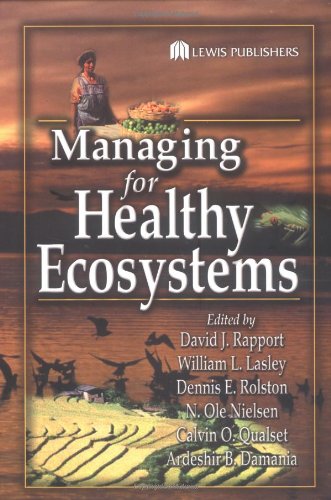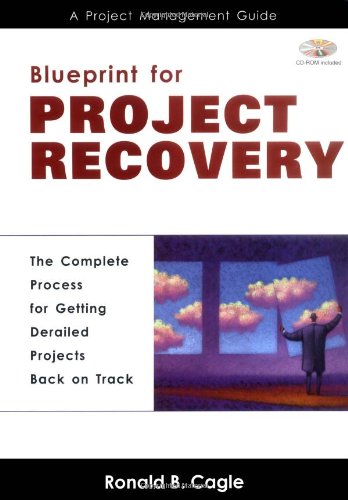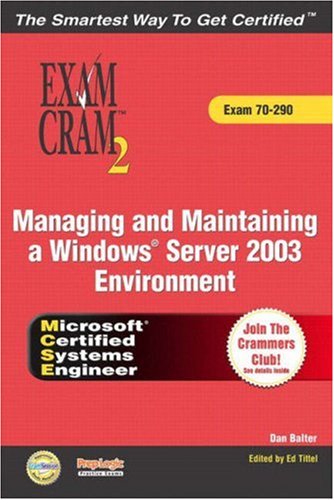David J. Rapport, Bill L. Lasley, Dennis E. Rolston, N. Ole Nielsen, Calvin O. Qualset, Ardeshir B. Damania9781566706124, 1-56670-612-2
Table of contents :
1566706122……Page 1
Preface……Page 6
International Congress on Ecosystem Health……Page 8
Supporters of the International Congress on Ecosystem Health……Page 10
Contributors……Page 12
Table of Contents……Page 24
PART I: Emerging Concepts……Page 38
SECTION I.1 Setting the Stage……Page 40
CHAPTER 1. Regaining Healthy Ecosystems: The Supreme Challenge of Our Age……Page 42
CHAPTER 2. The Politics of the Environment……Page 48
CHAPTER 3. Environmental Health Research Challenges……Page 52
CHAPTER 4. Toward Ecoresponsibility: The Need for New Education, New Technologies, New Teams, and New Economics……Page 58
SECTION I.2 Perspectives on Ecosystem Health……Page 64
CHAPTER 5. Overview: Perspectives on Ecosystem Health……Page 66
CHAPTER 6. The Ethics of Ecological Integrity and Ecosystem Health: The Interface……Page 68
CHAPTER 7. Ecological Integrity and Material Growth: Irreconcilable Conflict?*……Page 78
CHAPTER 8. Population Health Issues in the Management of Air Quality*……Page 92
CHAPTER 9. Global Environmental Changes and Health: Approaches to Assessing Risks……Page 106
CHAPTER 10. Climate Change and Health: New Research Challenges*……Page 114
CHAPTER 11. Use of Meteorological Data to Predict Mosquito-Borne Encephalitis Risk in California: Preliminary Observations in Kern County……Page 124
CHAPTER 12. Preparing for the Quantum Leap to Sustainability: A Toolkit for Future-Friendly Cities……Page 132
SECTION I.3 Building Policies and Linkages……Page 142
CHAPTER 13. Overview: Building Policies and Linkages……Page 144
CHAPTER 14. The CALFED Bay–Delta Ecosystem Restoration Program: Complexity and Compromise*……Page 146
CHAPTER 15. Understanding the Politics of Ecological Regulation: Appropriate Use of the Concept of Ecosystem Health……Page 158
CHAPTER 16. Attitudes and Their Influence on Nature Valuation and Management in Relation to Sustainable Development……Page 164
CHAPTER 17. Humane Values as a Basis for Ecosystem Health……Page 182
CHAPTER 18. The Role of the Water Education Foundation in Creating Factual Awareness and Facilitating Consensus in Western Water Issues……Page 188
CHAPTER 19. Addressing Threats to the Health of Coastal and Near-Coastal Ecosystems — The Gulf of Mexico*……Page 194
SECTION I.4 Setting Goals and Objectives in Managing for Healthy Ecosystems……Page 200
CHAPTER 20. Overview: Setting Goals and Objectives in Managing for Healthy Ecosystems……Page 202
CHAPTER 21. Adaptive Restoration: A Strategic Approach for Integrating Research into Restoration Projects……Page 204
CHAPTER 22. Appropriate Use of Ecosystem Health and Normative Science in Ecological Policy……Page 212
CHAPTER 23. Ecosystem Health: A Flawed Basis for Federal Regulation and Land-Use Management……Page 224
CHAPTER 24. Quality of Life, Recreation, and Natural Environments: Exploring the Connection……Page 236
CHAPTER 25. Natural Capital Differentiation, Sustainability, and Regional Environmental Policy*……Page 244
SECTION I.5 Finding Indicators……Page 266
CHAPTER 26. Overview: Can We Develop and Utilize Indicators of Ecological Integrity to Manage Ecosystems Successfully?……Page 268
CHAPTER 27. A Conceptual Framework for Choosing Indicators of Ecological Integrity: Case Study of the San Francisco Bay–Delta–River System……Page 272
CHAPTER 28. Establishing Specifications for Ecological Indicators for the Prediction of Sustainability……Page 284
CHAPTER 29. Measuring the Impact of Ecological Disintegrity on Human Health: A Role for Epidemiology……Page 296
CHAPTER 30. Development of a Terrestrial Index of Ecological Integrity (TIEI), a New Tool for Ecosystem Management……Page 304
CHAPTER 31. U.S. EPA Office of Research and Development Guidelines for Technical Evaluation of Ecological Indicators……Page 314
CHAPTER 32. Toward a Forest Capital Index……Page 322
SECTION I.6 Monitoring, Learning, and Adjusting……Page 336
CHAPTER 33. Overview: Monitoring, Learning, and Adjusting……Page 338
CHAPTER 34. Ecosystem Health and Economic Development: Rural Vision to Action……Page 340
CHAPTER 35. Agricultural Biodiversity: A Key Element of Ecosystem Health and Sustainable Food Security*……Page 354
CHAPTER 36. Evolving Opportunities for Management of Agricultural Landscapes and Ecosystem Health: Sustainability by Opportunity……Page 370
CHAPTER 37. The Ecological Footprint as Indicator for Sustainable Development — Results of an International Case Study……Page 380
PART II: Issues and Methods……Page 390
SECTION II.1 Managing for Biodiversity……Page 392
CHAPTER 38. Overview: Managing for Biodiversity……Page 394
CHAPTER 39. The Greater Addo National Park, South Africa: Biodiversity Conservation as the Basis for a Healthy Ecosystem and Human Development Opportunities……Page 396
CHAPTER 40. The Role of an Accidentally Introduced Fungus in Degrading the Health of the Stirling Range National Park Ecosystem in Southwestern Australia: Status and Prognosis……Page 412
CHAPTER 41. Mangrove Conservation and Restoration for Enhanced Resilience……Page 426
CHAPTER 42. A Comparison of Landscape Change Detection Methods……Page 440
CHAPTER 43. Relationships among Environmental Stressors and Fish Community Composition and Health: Case Study of Chesapeake Bay……Page 450
SECTION II.2 Assessing and Monitoring Biodiversity……Page 466
CHAPTER 44. Overview: Assessing and Monitoring Biodiversity……Page 468
CHAPTER 45. Management and Conservation of Tropical Forests with Emphasis on Rare Tree Species in Brazil……Page 472
CHAPTER 46. The Effects of Roads on Carnivores: A Case Study of Mountain Lions (Puma concolor) in California……Page 478
CHAPTER 47. A Rapid Method in Ecosystem Mapping and Monitoring as a Tool for Managing Costa Rican Ecosystem Health……Page 486
CHAPTER 48. Identification and Monitoring in the Context of the National Biodiversity Strategy in Uruguay……Page 496
SECTION II.3 Climate Change and Ecosystem Health……Page 500
CHAPTER 49. Overview: Climate Change and Ecosystem Health……Page 502
CHAPTER 50. Climate Change, Birds, and Ecosystems — Why Should We Care?……Page 508
CHAPTER 51. A Checklist for Historical Studies of Species’ Responses to Climate Change……Page 514
CHAPTER 52. Use of Long-Term Field Trial Datasets in Forestry to Model Ecosystem Responses to Environmental Change……Page 524
CHAPTER 53. The Possible Impacts of Climate Change on Pacific Island State Ecosystems……Page 532
CHAPTER 54. Modeling Asssessment of the Biological and Economic Impact of Increased UV Radiation on Loblolly Pine in the Middle Atlantic States……Page 550
SECTION II.4 Exotic Species: Eradication Revisited……Page 566
CHAPTER 55. Overview: Exotic Species: Eradication Revisited……Page 568
CHAPTER 56. Eradication: Is It Ecologically, Financially, Environmentally, and Realistically Possible?……Page 570
CHAPTER 57. Why Not Eradication?……Page 578
CHAPTER 58. Eradication of Introduced Marine Pests……Page 586
SECTION II.5 Landscape Health Assessment……Page 594
CHAPTER 59. Overview: Landscape Health Assessment……Page 596
CHAPTER 60. Multiscale Advanced Raster Map Analysis System for Measuring Ecosystem Health at Landscape Scale-A Novel Synergistic Consortium Initiative……Page 604
CHAPTER 61. Application of Landscape Models to Alternative Futures Analyses……Page 614
CHAPTER 62. Echelon Screening of Remotely Sensed Change Indicators……Page 626
CHAPTER 63. Grassland Bird Communities and Environmental Health: The Role of Landscape Features……Page 632
CHAPTER 64. An Ecosystem Approach to Human Health……Page 640
CHAPTER 65. Predictability of Bird Community-Based Ecological Integrity Using Landscape Measurements……Page 654
CHAPTER 66. Landscape Biodiversity and Biological Health Risk Assessment: The Map of Italian Nature……Page 676
CHAPTER 67. Interior Columbia Basin Forests and Rangelands, 1930s to Present……Page 698
SECTION II.6 Communities, Politics, Culture, and Tradition……Page 730
CHAPTER 68. Overview: Communities, Politics, Culture, and Tradition……Page 732
CHAPTER 69. Gambling for Sustainability-Local Institutions for Pasture Management in Bhutan……Page 734
CHAPTER 70. Environmental and Socioeconomic Indicators of Great Lakes Basin Ecosystem Health……Page 740
CHAPTER 71. Control of Natural Resource Degradation to Restore Ecosystem Health and Help Secure Peace in the Middle East……Page 758
CHAPTER 72. Biological Conservation in Mexico: An Overview……Page 768
CHAPTER 73. Environmental Impacts of Mobility and Urban Development: A Case Study of the Brussels-Capital Region……Page 778
CHAPTER 74. Relating Indicators of Ecosystems Health and Ecological Integrity to Assess Risks to Sustainable Agriculture and Native Biota- A Case Study of Yolo County, California……Page 794
CHAPTER 75. Nature Policy Assessments: Strategic Survey and Assessing Progress across Policy Levels……Page 806
CHAPTER 76. Land-Use Due to Urbanization for the Middle Atlantic Integrated Assessment Region of the Eastern United States……Page 814
SECTION II.7 Agriculture and Human Health……Page 824
CHAPTER 77. Overview: Agriculture and Human Health……Page 826
CHAPTER 78. Effects of Agriculture on Ecosystem and Human Health……Page 830
CHAPTER 79. Infectious Disease Hazards to Agricultural Workers……Page 836
CHAPTER 80. Size Distribution of PM Sol Dust Emissions from Harvesting Crops……Page 838
CHAPTER 81. Evaluating Pesticide Effects on Ecosystems and Human Health: The Rotenone Application at Lake Davis……Page 844
SECTION II.8 Mining Impacts……Page 852
CHAPTER 82. Overview: Mining Impacts……Page 854
CHAPTER 83. The Ecosystem Approach to Human Health in the Context of Mining in the Developing World……Page 856
CHAPTER 84. Issues of Scale in the Selection and Interpretation of Mineral Indicators……Page 872
CHAPTER 85. Conceptual Approaches to Health and Well-Being in Minerals Development: Illustrations with the Case of HIV/AIDS in Southern Africa……Page 880
CHAPTER 86. Mining and Indigenous Peoples: Contributions to an Intercultural and Ecosystem Understanding of Health and Well-Being*……Page 900
CHAPTER 87. Integrating Human Health into an Ecosystem Approach to Mining……Page 918
CHAPTER 88. A Conceptual Framework for the Development of Tools to Track Health and Well-Being in a Mining Region: Report from an Indian Study*……Page 928
CHAPTER 89. Addressing Gaps in Ecosystem Health Assessment: The Case of Mineral Resources……Page 942
SECTION II.9 Forest Health Monitoring and Restoration……Page 954
CHAPTER 90. Overview: Forest Health Monitoring and Restoration……Page 956
CHAPTER 91. Resistance and Elasticity: A Conceptual Framework for Managing Secondary Forest Ecosystems in Switzerland……Page 958
CHAPTER 92. The Precautionary Principle and Ecosystem Health: A Case Study from the Jarrah Forest of Southwestern Australian……Page 972
CHAPTER 93. National Indicators of Forest Ecosystem Health: A Science Perspective on the Canadian Initiative……Page 986
CHAPTER 94. Forest Health Monitoring in the U.S.: A West Coast Perspective……Page 1000
SECTION II.10 Agroecosystems……Page 1014
CHAPTER 95. Overview: Integrating Agricultural Production with Ecosystem Health……Page 1016
CHAPTER 96. Fallow Land Patches and Ecosystem Health in California’s Central Valley Agroecosystem……Page 1018
CHAPTER 97. Reduced-Disturbance Agroecosystems in California……Page 1030
CHAPTER 98. Ecologically Based Pest Management: A Key Pathway to Acheiving Agroecosystem Health……Page 1036
CHAPTER 99. Irrigation, Agricultural Drainage, and Nutrient Loading in the Upper Klamath Basin……Page 1048
SECTION II.11 Grazing Animals and Rangelands……Page 1064
CHAPTER 100. Overview: Grazing Animals and Rangelands……Page 1066
CHAPTER 101. Changing Public Perceptions of the Ranch: A Preliminary Review of Ancient and Contemporary Claims and Processes……Page 1068
CHAPTER 102. A Racher’s Eye View of Grazing Native Grasslands in California……Page 1074
CHAPTER 103. California Grazing Lands: Science Policy and the Rancher……Page 1078
CHAPTER 104. Reinventing the Range: To Graze or Not to Graze Is Not the Question……Page 1084
CHAPTER 105. Califronia Grazing Lands: Wither They Go*……Page 1092
CHAPTER 106. Protecting the Biodiversity of Grasslands by Livestock in California……Page 1102
PART III: Case Studies……Page 1108
Section III.1 The Colorado River Delta Ecosystem, U.S.-Mexico……Page 1110
CHAPTER 107. Overview: The Colorado River Delta Ecosystem: Ecological Issues at the U.S.-Mexico Border……Page 1112
CHAPTER 108. Physical and Biological Linkages between the Upper and Lower Colorado Delta……Page 1114
CHAPTER 109. Migratory Bird Conservation and Ecological Health in the Colorado River Delta Region……Page 1128
CHAPTER 110. Wildlife Disease in the Colorado Delta as an Indicator of Ecosystem Health……Page 1148
CHAPTER 111. Contaminants witout Borders: A Regional Assessment of the Colorado River Delta Ecosystem……Page 1162
CHAPTER 112. Conservation Value and Water Management Issues of the Wetland and Riparian Habitats in the Colorado River Delta in Mexico……Page 1172
SECTION III.2 Canadian Prairie Ecosystem……Page 1184
CHAPTER 113. Overview: Sustainability of the Semiarid Prairie Ecosystem, Canadian Prairie Ecosystem Study (PECOS)……Page 1186
CHAPTER 114. Historical Land Use and Ecosystem Health of the Canadian Semiarid Prairie Ecosystem……Page 1190
CHAPTER 115. Health and Well-Being in a Changing Environment: Perceptions of a Rural Senior Saskatchewan Population……Page 1198
CHAPTER 116. Prairie Ecosystems Study (PECOS): From Community to Chemical Elements, the Essential Role of Questionnaires……Page 1206
CHAPTER 117. Ecosystem-Level Functional Changes in Breeding Bird Guilds in the Mixed Grassland since Agricultural Settlement……Page 1220
CHAPTER 118. Evaluating Agroecosystem Sustainability Using an Integrated Model……Page 1246
CHAPTER 119. Prediction of Soil Salinity RIsk by Digital Terrain Modeling in the Canadian Prairies*……Page 1264
SECTION III.3 Aquatic Ecosystems: Lake Tahoe and Clear Lake, California……Page 1272
CHAPTER 120. Overview: Aquatic Ecosystems: Lake Tahoe and Clear Lake, California……Page 1274
CHAPTER 121. Evaluating and Managing a Multiply Stressed Ecosystem at Clear Lake, California: A Holistic Ecosystem Approach……Page 1276
CHAPTER 122. Trans-Gill and Dietary Uptake of Methyl Mercury by the Sacramento Blackfish, a Planktivorous Freshwater Fish……Page 1310
CHAPTER 123. An Integrated Watershed Approach to Studying Ecosystem Health at Lake Tahoe, CA-NV……Page 1320
SECTION III.4 Aquatic Ecosystems: New Your, Maryland, and Florida……Page 1336
CHAPTER 124. Overview: Aquatic Ecosystems: New York, Maryland, and Florida……Page 1338
CHAPTER 125. A Tale of Two Models: IMPLAN and REMI on the Economics of Everglades Restoration……Page 1340
CHAPTER 126. Analysis of Land Cover and Water Quality in the New York Catskill-Delware Basins……Page 1364
CHAPTER 127. Using a Knowledge Base to Assess the Effects of Stream Stressors……Page 1378
SECTION III.5 The Langat Basin of Malaysia……Page 1394
CHAPTER 128. Overview: The Langat Basin of Malaysia……Page 1396
CHAPTER 129. Ecosystem Health in Malaysia: A Case Study of the Langat Basin……Page 1398
CHAPTER 130. Manufacturing Industries and Ecosystem Health: The Case of the Langat Basin……Page 1408
CHAPTER 131. Diagnosing Ecosystem Health of the Lnagat Basin in the Cortext of Geohazards……Page 1422
CHAPTER 132. River Water Quality Assessment and Ecosystem Health: Langat River Basin, Selangor, Malaysia……Page 1432
CHAPTER 133. Forest Areas and Wildlife Diversity in the Langat Basin: Indicators for Assessing Langat Basin Ecosystem Health……Page 1458
SECTION III.6 Pollution: MTBE……Page 1468
CHAPTER 134. Overview: Environmental Impacts of a Motor Fuel Additive: Methyl Tertiary Butyl Ether (MTBE)……Page 1470
CHAPTER 135. MTBE in Groundwater of the U.S: Occurrence, Potential Sources, and Long-Range Transprot……Page 1472
CHAPTER 136. The European Perspective of MTBE as an Oxygenate in Fuels……Page 1484
CHAPTER 137. Cost-Benefit Considerations for the Introdution of Gasoline Additives Such as MTBE……Page 1496
Index……Page 1506







Reviews
There are no reviews yet.